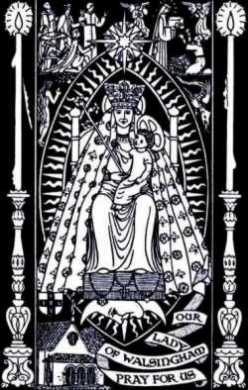
 The view from my room, what a view! (the cows were really friendly).
The view from my room, what a view! (the cows were really friendly). The view from the other window in my bedroom over the beautifully manicured gardens and slope down towards the main house.
The view from the other window in my bedroom over the beautifully manicured gardens and slope down towards the main house. The cottage I stayed in (with the red door).
The cottage I stayed in (with the red door).On Easter Monday, after all the wonderful liturgy at St Hilda's and hard work that goes into such things, I packed my bag and caught the train to St Beuno's in North Wales for 7 days of peace and quietness on an 'Individually Guided Retreat' inspired by Ignatius of Loyola's Spiritual Exercises.
St Beuno's is now a retreat house, but was originally built in 1850 (ish) as a seminary for the Jesuits. Incidentally, St Beuno's was designed by Hansom (of the Hansom Cab, he also designed the RC Church of the Holy Name of Jesus in Manchester, famed for its wonderful Priest and liturgy). Gerard Manley Hopkins, Jesuit priest and poet, (1844-1889) lived at St Beuno's for three years from 1874 to 1877, studying theology in preparation for the priesthood. During those years he wrote some of his best loved poems. Hopkins wrote The Wreck of the Deutschland whilst at St Beuno's. While the entire poem is strongly autobiographical, four lines in particular point the contrast between the calm he enjoyed (and myself) at St Beuno's and the violence of the death-dealing storm:
Away in the loveable west,
On a pastoral forehead of Wales,
I was under a roof here, I was at rest,
And they the prey of the gales:
Hopkins' final year at St Beuno's College, was marked by an upsurge of creative activity as the climax of ordination drew nearer. Poetry simply poured out of him, including, God's Grandeur, The Starlight Night, In the Valley of the Elwy, The Sea and the Skylark and The Windhover, which he said, was the best thing he ever wrote.
Hopkins had the eye of an artist and it is easy to understand his early desire to be a painter. Yet his interest went further than word-painting, however brilliant. For like the psalmist, he saw God all around him in creation. He could recognise Christ's beauty in a bluebell. So whether he walked the local footpaths, through the fields, climbed the hills, or fished the rivers, he was constantly catching glimpses of God.
Hopkins exclaims:
I walk, I lift up, I lift up heart, eyes,
Down all that glory of the heavens to glean our Saviour.
Hopkins' aim was to 'Give' beauty back to God, beauty's self and beauty's giver. In doing so he was putting into practice Ignatius' counsel, 'to place the whole affection on the Creator, loving Him in all creatures'.
I have taken various photographs to share with you over the next two-three weeks. I do hope you enjoy them as much as I enjoyed my time at St Beuno's, the local countryside, walkways, paths, early Spring flowers, bluebells and time alone to deepen my relationship with God.
Signed: Christopher McGuinness (aka: A Hildaite).



_Black_s_s_s_s_s.jpg)
